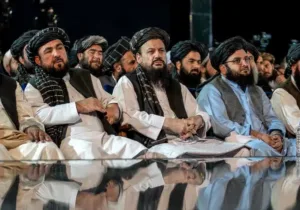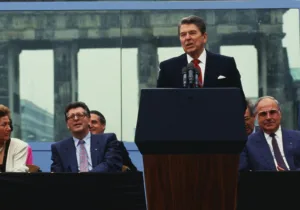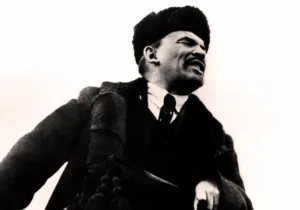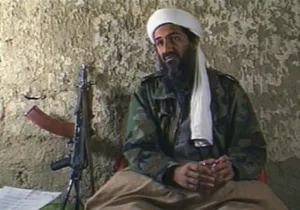Since Hamas’s atrocities on October 7, there has been a flood of vitriol launched against Israel, despite being the victim of an attack and engaging only in justifiable self-defense. Posters of Israeli hostages have been torn down, pro-Israel demonstrators have been assaulted, university professors have called the mass murder of Jews “exhilarating,” and antisemitic protests against Israel and the US have rocked cities across the West. The culprits in these profoundly immoral acts tend to come from one of two political ideologies: leftism and Islamism.
One may think that, on the surface, these movements have very little in common – besides antisemitism, of course. But this Red-Green alliance – so labeled for the colors of communism and Islam, respectively – shares enough to form a union of convenience around their joint goal: the undermining of Western institutions, culture, and geopolitical power. For the progressive-Islamist bloc, these all fall under the rubric of opposing so-called “Western imperialism.” No two nations symbolize this hated ideology more than the United States and Israel. The two halves of the Red-Green coalition also share tactics and strategies; they utilize agitation and propaganda to exploit emotion and delegitimize their foes, see the world in starkly Manichaean terms, strongly police and stifle internal dissent, and live by the motto “the ends justify the means.”
This unholy alliance is running rampant in nearly every major Western city, where their mass demonstrations are now a regular occurrence. Islamic radicals and left-wing activists join hands to call for a free Palestine “from the river to the sea,” misrepresent Hamas propaganda as neutral fact, and downplay or entirely ignore the massacre of thousands of innocent Israeli citizens – they’re settler-colonialists, after all. This may seem like a startling new development in politics, but the Red-Green alliance has a long history; one oftentimes far more favorable for the Islamists than their progressive comrades.
The nexus between leftism and political Islam has roots in the earliest days of the Soviet Union. The new state which the Bolsheviks sought to build on the ashes of the Romanov dynasty would include, as did its predecessor, a substantial Muslim minority centered in key strategic locales like the Caucasus and Central Asia. During the brutal Russian Civil War, Soviet leaders sought to conciliate these populations and bring them into the fight against the Western-backed Whites. The Red Army concluded deals with armed Islamist groups across the region, using them to beat back the anti-Bolshevik forces and freeing up regular army troops for attacks on other White detachments.
To accomplish this, the Bolsheviks stood on the shared cause of anti-imperialism, inflecting it with a decidedly religious bent when messaging to Muslim communities. In the 1920 Congress of the Peoples of the East, held by the Communist International in Baku, Russian communist leaders interfaced with their Islamist counterparts to combat “Western imperialism.” The influential Soviet leader Grigory Zinoviev headlined the conference, calling for “a true people’s holy war against the robbers and oppressors… a holy war, in the first place against British imperialism!” This exhortation for a Red-Green alliance was met with ecstatic applause. After the Red Army’s victory, the Soviet Union under Lenin continued its push to align Muslim communities with its communist vision by cultivating Islamic clerics as proponents of Soviet power. In Soviet archival documents, this cynical plan to co-opt Islamic leaders for the sake of anti-Western influence was laid out in stark terms. After Lenin’s death and the rise of Stalin, this was seen as a waste of effort and Muslims were persecuted once again.
The Red-Green alliance accelerated in the post-Stalin era, especially within the Middle East, where the Soviets sought to conciliate Islamism to counter America during the Cold War. Going forward, however, it was often the Islamists in the driver’s seat, using Soviet largesse to their own political benefit. Leaders of Islamist movements sought to “develop a modern political ideology based on Islam, which they [saw] as…the best means of confronting foreign imperialism.” This dovetailed perfectly with the USSR, which presented itself as the anti-imperialist force par excellence. Islamists used this shared value to gain Soviet backing for their own aims; the Soviets funded and supported Islamist regimes, pan-Arabist movements, and Palestinian guerrillas, all of whom sought the end of Israel and American influence in the region. Leaders like Egypt’s Gamal Abdel Nasser, Syria’s Hafez al-Assad, and PLO head Yasser Arafat (as well as his successor, Mahmoud Abbas) all had deep ties to Moscow, from which they benefited handsomely.
The most significant Cold War example of the Red-Green alliance in action was in Iran. The Iranian Revolution was a “revolt of society against the state,” bringing together a variety of opponents to the Shah’s regime – nationalists, liberals, Marxists, and Islamists. The latter two groups made the largest impact on the revolution’s ideology and eventual success, teaming up under the watchful eye of the USSR to demonize the Shah as a puppet of Western imperialists, namely Israel and America. After the abdication of the Shah, the Green faction under Ayatollah Ruhollah Khomeini turned on its Red allies and marginalized them. Iran was declared an Islamic Republic in April 1979 and its anti-imperialist bona fides were proven by taking 66 American hostages that November. That action allowed the mullahs to contend that they were even more anti-imperialist than their former Marxist partners. The Mujahadeen-e-Khalq (MEK), the Red half of the coalition, was forced into exile shortly thereafter. Still, the Islamist regime in Tehran remained close to the Soviets, despite the MEK defenestration, as they shared a primary objective: waging war against the West.
Once the Red half of the Cold War coalition fell in 1991, Islamists had to look elsewhere for their comrades of convenience. They sought the next best thing to the actual Soviet Union: its biggest and most influential supporters, progressive Western activists and academics. The Red-Green alliance thus shifted in composition and location, moving into European politics with the mass influx of Muslim migrants in addition to growing collaboration in North America. Islamists and the radical left found common cause once again in anti-imperialism, this time lambasting the West for forcefully responding to Islamic terrorism post-9/11. Protests against America’s invasions of Iraq and Afghanistan erupted across Europe, America, and the Middle East, linking Islamists and progressives in what Washington Post writer Michael Kelly called “a furious, permanent, reactionary opposition to the devil-state America, which stands as the paramount evil of the world.” Groups like ANSWER (Act Now to Stop War and End Racism) are perfect examples of this post-Cold War Red-Green alliance, bringing together leftists and Islamists to march against American and Israeli “occupation” – both in the immediate aftermath of 9/11 and in the present day.
Outright Islamic terror groups like Hezbollah have made significant inroads within the Western progressive movement, being embraced in some quarters as a “strong partner” of the international left. The presidency of Barack Obama saw further interconnection between Red and Green, especially in the realm of foreign policy. The Obama administration turned against Israel, coddled Iran, and advanced its regional ambitions, and made nice with Islamist groups including the Muslim Brotherhood. Those actions have reverberated to the present, contributing heavily to the current crisis in Israel.
During his time in office, the rhetoric of “social justice” suffused the left, allowing another entry point for Islamists to strengthen Red-Green cooperation. Muslim Brotherhood-linked organizations like CAIR (the Council on American-Islamic Relations) became “an integral part of the progressive movement,” adopting the language of intersectionality and using it to achieve their political goals, including increased Muslim immigration and mass acceptance of refugees from Islamist cultures. This integration of leftist social justice pablum into Western Islamist activism is how we got to the point where progressives are marching with banners reading “Queers for Palestine,” despite the antipathy most Islamists and Palestinians feel for the LGBT community.
We saw an inflection point in the American chapter of the global Red-Green alliance, notably during the Trump years, where talk of “Muslim bans” drove progressives and Islamists closer together. Anti-American radicalism exploded on college campuses, both in the student body and the professoriate. The BDS (Boycott, Divestment, Sanctions) movement is the exemplar of this trend. Launched in 2005 – ironically enough, the same year Israel unilaterally withdrew from Gaza – BDS is a joint Red-Green effort to delegitimize the nation of Israel by falsely labeling it an “apartheid state.” Since its creation by Palestinian activists, BDS has been widely embraced on college campuses and among the American left, including by organizations like Jewish Voice for Peace (JVP) and Students for Justice in Palestine (SJP). The Palestinian side of the movement has deep ties to terrorist organizations like the Popular Front for the Liberation of Palestine (PFLP) and Hamas. Some BDS leaders have previously been imprisoned for their terrorist crimes, including murder, but none of this seems to faze the Western leftists who march in lockstep with them.
This history of the Red-Green partnership, particularly in the post-9/11 era, has manifested itself in the present in disturbing ways. Groups like JVP and SJP have been at the forefront of the anti-Israel protests over the past few weeks, bringing their campus activism and their ties to Islamist ideology to a new, more dangerous level. Arab-American and progressive voters have joined together to declare their disappointment in President Biden for his support of Israel, threatening to withhold their votes unless a Hamas-favored ceasefire is forced. Left-wing representatives in Congress, particularly the infamous “Squad,” have forwarded antisemitic tropes, blatant lies about Israel, and incendiary accusations of war crimes. Violence has been directed at Jews and supporters of Israel across the Western world, much of which has been excused by the progressive left.
All of this is part and parcel of the history of the Red-Green alliance. Partnerships of convenience between Islamists and the left have been made for over a century, with varying winners and losers. In the recent past, the Islamist adoption of progressive social justice messaging has ingratiated them into the leftist movement without forcing any changes to their noxious ideology. In the end though, neither side really cares about the serious differences in their politics as long as they agree on the most important thing: the destruction of the Western order, which both decry as ‘imperialist.’ They use the same aggressive tactics, share the same media strategy, seek totalitarian control of society, and describe their struggles in all-or-nothing, existential terms. They both glorify ‘righteous’ violence, as long as the target is the proper one. And they join together in their hatred of Western civilization and the regnant world order – focusing their common ire on two key exponents of that system, Israel and the United States. To defend our civilization against the barbarians at the gates, we need to confront the new Red-Green alliance head-on. Without recognizing the intrinsically toxic ideology present at the center of Red-Green collaboration, we will never be able to save Israel and America.






 Sponsor a student for Christianity & National Security 2024
Sponsor a student for Christianity & National Security 2024